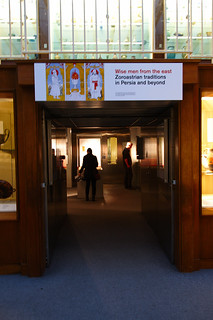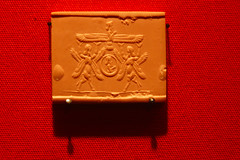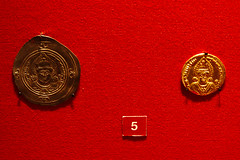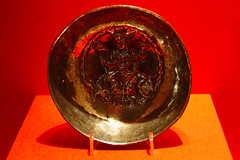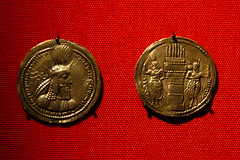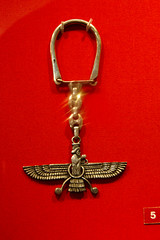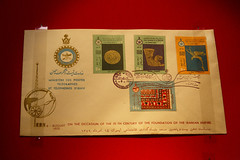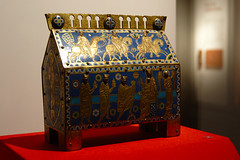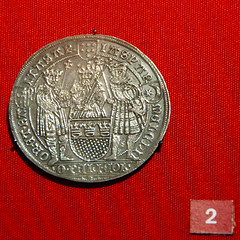The second of the two talks we went to at the British Museum Members’ Open Evening the other week was about the small exhibition of Zoroastrian and related pieces that has recently opened at the BM. This is in some ways a related exhibition to the larger Zoroastrian exhibition at SOAS which finishes soon (we went to see it the other day so I shall be writing that up soon). In this post I’m going to talk about both the exhibition and the curator’s talk.rather than split them into separate posts. My photos are up on flickr here.
The curator, Vesta Curtis, started by telling us that she herself is Iranian, and her professional interest is in royal iconography on pre-Islamic Iranian coins. She’s taken advantage of interest generated by the other Zoroastrian exhibition to draw people in to look at her coins. The other strand of the exhibition is to look at how the Zoroastrian iconography has influenced both modern Iran and the Western world (hence the “Wise Men from the East” bit of the exhibition title).
The Zoroastrian religion is named (by outsiders) after its prophet Zoroaster or Zarathustra. He lived somewhere between 1800BC and 600BC (amusingly one of the audience at the talk thought Curtis meant he lived that long, but no she meant the much more plausible fact that his dates are unknown). The primary god is Ahura Mazda, sometimes shown as a winged figure. This same iconography can be used as representation of the concept of Kingly Glory, and it’s not always clear which it is in a given context. The Zoroastrians see the world as a battleground between good and evil forces, and see the role of humanity as working to aid the good force. Curtis said in some ways it’s an eco-friendly religion, as one of it’s precepts is that a good person should not pollute the natural elements (like water, fire, earth).
The religion started in Iran and spread to India. Curtis had displayed a selection of coins and seals which depicted Zoroastrian iconography from across the region and across time from c.400BC through to the 1600s AD. In modern Iran the winged figure of Ahura Mazda or the Kingly Glory has become a secular national symbol. Curtis was telling us that a lot of people, in particular the younger generation, in Iran have some piece of jewellery or accessory with this figure on it – even non-Zoroastrians. It’s a symbol that emphasises the long history of Iran, and to go with this theme in the exhibition there were some stamps released in 1970 to celebrate 2500 years of the Persian Empire.
The impact on the Western world is via Christianity. The three Wise Men who bring gifts to the infant Jesus are generally depicted in Persian dress. Even the name we use for them – the Magi – derives from the Persian word for a Zoroastrian priest. From the word Magi we also get “magician” and “magic”. One of the Magi is possibly an Indo-Parthian King called Gondaphares, his name is corrupted to Caspar or Jasper in the Christian texts. I admit I’m not clear if there was more evidence than just the name to link the two or not.
This was an interesting talk and exhibition, but I think it was a little unfocused for such a small collection. Coins were clearly Curtis’s thing, and I think in trying to give it a broader appeal it ended up with a few too many only tangentially related things. Still, I likely wouldn’t’ve gone to look if it had all been coins (because they’re not really my thing), so it did the job right in that sense 🙂

